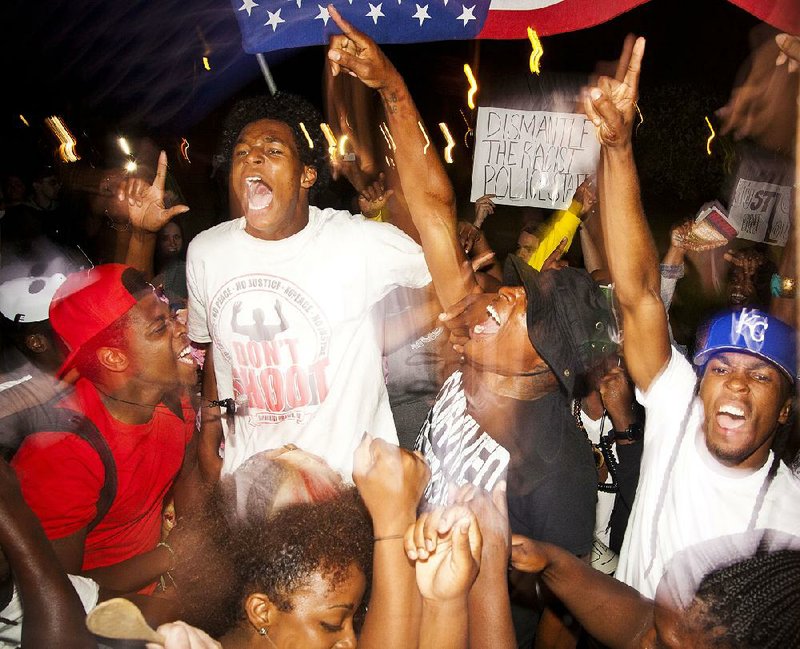Whose Streets? is a raw and often unfocused documentary by St. Louis-based interdisciplinary (he paints, draws and makes music as well as moving images) artist Damon Davis and activist/storyteller Sabaah Folayan. It is not a slick project; one gets the feeling the co-directors are not very concerned with what anyone might think of their filmmaking prowess. This is a message movie, powerful and compelling.
That's not to suggest it's likely to change any minds -- the Balkanization of media makes it too easy for us to ignore what we shouldn't, and it seems doubtful that Whose Streets? will be noticed by that part of America that rejects the film's premise. For a lot of people, the 2014 killing of 18-year-old Michael Brown in Ferguson, Mo., is an open-and-shut case of the police doing their difficult job. For them, Brown's death may (or may not) be a sad consequence of his short life of petty criminality. They would argue that we can't expect cops to be perfect, that we have to allow them to defend themselves against perceived threats.
Whose Streets?
87 Cast: Documentary with David Whitt, Brittany Ferrell, Tef Poe, Kayla Reed, Tory Russell, Alexis Templeton
Directors: Sabaah Folayan, Damon Davis
Rating: R, for language
Running time: 1 hour, 30 minutes
But viewed in the historical context of police relations with black communities in this country, Brown's death represents another data point in a disturbing pattern. Time and again we've witnessed the scenario play out: a young black man seen as threatening is killed by police (or in the case of Trayvon Martin, killed by a police wannabe) and, after the appropriate deliberations, the killing is ruled justifiable.
Brooklyn-based Folayan -- one of the organizers of the Millions March, a December 2014 protest precipitated by the failure to indict an NYPD officer following the in-custody death of Eric Garner -- traveled to Ferguson in the aftermath of Brown's shooting intending to write about it. Struck by the contrast between what she was witnessing and what she saw presented in the media, she decided to make a film. She encountered Davis in Ferguson, and the two decided to collaborate.
The film begins with a driving tour of the little community, with two young men providing a running commentary that touches on one of the root problems of their hometown -- a dismal education system.
"People straight up raising children that cannot read," one says. "That's really [messed] up. That ... is directly rooted back to slavery. You can't read -- you a slave."
Then the screen goes black and an infamous line from Supreme Court Chief Justice Roger B. Taney's majority opinion in the 1857 Dred Scott case -- "The Negro has no rights which the white man is bound to respect" -- appears, before we're deposited into the chaos following Brown's shooting.
Whose Streets? is largely the story of a community as it focuses on a number of local residents. Among these are David Whitt, a resident of an apartment complex on the street where the shooting took place and a member of Copwatch, an activist group that provides citizens with cameras to monitor the actions of police; activist-artist Tef Poe; Kayla Reed, a St. Louis-based civil rights activist; black queer activists Brittany Ferrell and Alexis Templeton, a couple who co-founded Millennial Activists United, who find themselves in legal jeopardy after leading a demonstration in which they blocked traffic; and Tory Russell, a local teacher whose questions for the Ferguson Police Department go unanswered.
Punctuated by quotations from black historical figures -- including Martin Luther King Jr.'s on-point observation that "a riot is the language of the unheard," the film bulls ahead, with a grab bag of smartphone-shot cinema verite interviews and archival footage; Darren Wilson, the 28-year-old policeman who shot Michael Brown, speaking in a television news interview, says, "You can't perform the duties of a police officer and have racism in you"), driven by the sometimes unfocused urgency of the filmmakers. This is a cri de coeur, not a marshalled argument.
Still, buried in the polemic are moments of grace. A protester confronts a young policewoman, the only black face in the long line of blue. The officer holds her ground, but tears stream down her face. Whitt explains that his 5-year-old son intends to become a boxer; when he urges the child to hit him, he hugs his father instead.
MovieStyle on 08/25/2017
